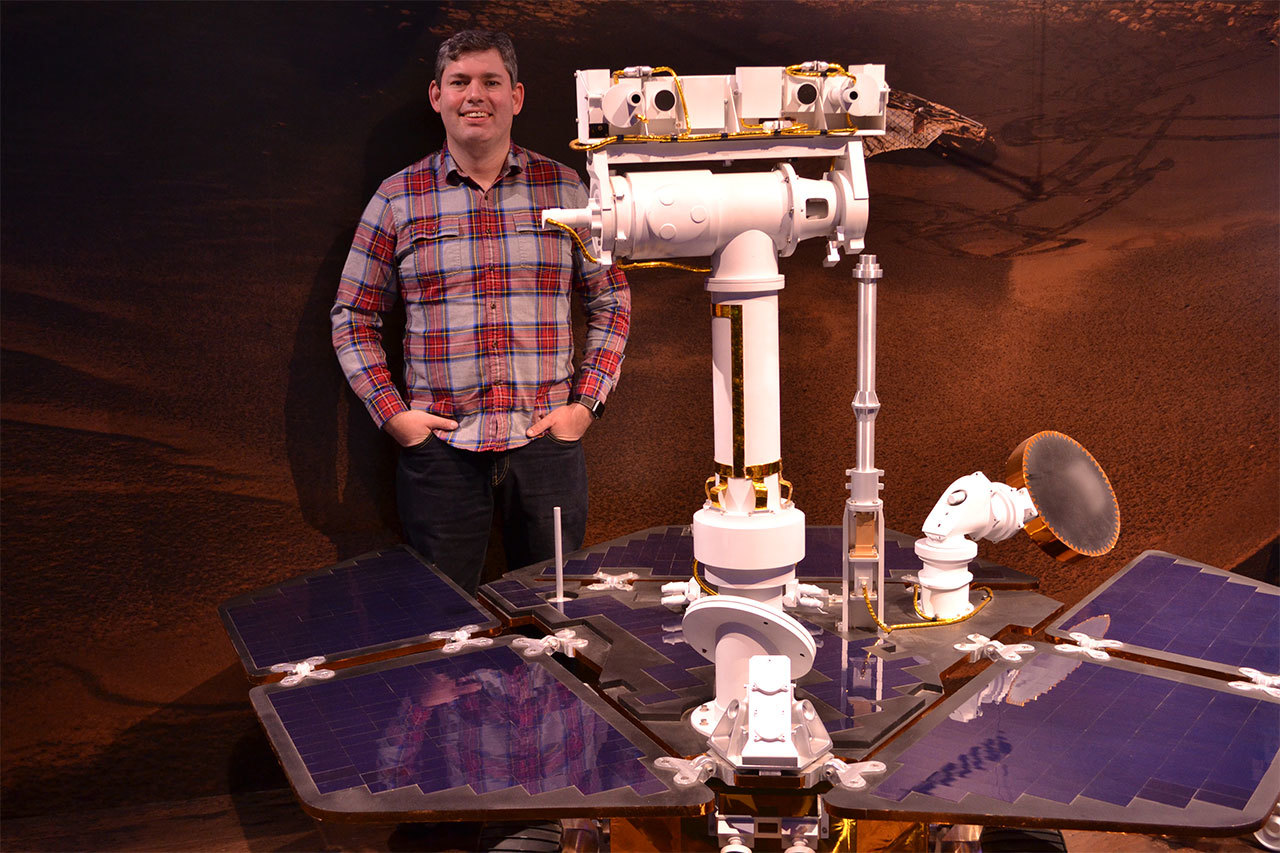News | April 10, 2018
Stitching Together a Career in Space Exploration

Doug and a Mars Exploration Rover model.
Today, I’m on shift as the Engineering Camera Payload Uplink Lead on NASA’s Mars Opportunity rover, planning two days of photo-taking for 400 pounds of thinking metal that’s been exploring Mars for more than 14 years. But how? We need to wind back a bit.
I grew up in rural England, with a fascination for all things space from the day I was given a small blue telescope by my father at Christmas. I knew I wanted to be involved in space exploration in some way, so after high school I headed off to study engineering at the University of Birmingham in the middle of England.
I hated it.
It wasn’t long before I realized I needed to make a dramatic change. At the end of the first year I left and started a three-year degree course in multimedia design at Demontfort University in Leicester. It wasn’t space exploration, but I was having fun. For individual class projects, I always did something related to space: animations of the ill-fated British Beagle 2 Mars lander, and NASA’s Stardust mission to Comet Wild 2, for example.
After graduating in 2001, I found a job working for a medical education company as a multimedia producer, working on DVDs and websites for training doctors and nurses. Space was temporarily off my radar, until 2004.
NASA’s twin rovers Spirit and Opportunity landed on Mars that year, and the mission leadership had decided that every image each of their nine cameras took would be posted immediately to the internet. I couldn’t help myself. I stitched together mosaics of navigation camera images myself, using Photoshop. I saw color images that could be assembled from images from the rovers’ PanCam and made those as well.
I set up a small online forum called Unmanned Spaceflight for people who were working with these images -- amateurs from around the world doing interesting things with this data. We started sharing the movies, maps, mosaics and color images we made and processed there, using real spacecraft information. Meanwhile I started other personal space projects -- animating 3D data from the HiRISE camera onboard the Mars Reconnaissance Orbiter, creating animations of the C1XS spectrometer on the Chandrayaan-1 Indian Lunar mission, and visiting astronomy societies and schools to talk about the Mars rovers.
Then things got weird.
In 2007 I got an invitation from the head of solar system outreach at NASA’s Jet Propulsion Laboratory, Alice Wessen, to talk about what amateurs do with data at the Europlanet conference in Postdam, Germany. I panicked -- I’d never been to a conference, so I asked for help from Emily Lakdawalla, the Planetary Society’s “planetary evangelist.” She cunningly suggested I attend as press on behalf of the society and present at the conference as well.
Now I was face to face with the JPL folks I’d been admiring for years, explaining what we amateurs did with their data. Somehow, I made quite the impression, because they invited me to speak again at the same conference the following year, and to visit JPL and talk to people there about amateur image processing, too.
By now it was the fall of 2009, and the company I was working for had a shrinking order book. They need to let someone go, and, without any plan as to what I might do next, I volunteered to leave the company. I had no idea what I would do next.
Within a few days, JPL offered me a job as a Visualization Producer. In the Spring of 2010, I moved 5,500 miles and started a new life in Pasadena, California.
I spent five years working in JPL’s Office of Communications and Education on a variety of projects. I was the technical director for the Curiosity Landing animation, and content lead for Eyes on the Solar System. In 2015, I joined JPL’s OpsLab to work on Destination Mars, an experience for the Microsoft HoloLens mixed reality headset that let visitors to NASA’s Kennedy Space Center walk on the surface of Mars.
Most recently, I moved into mission operations -- first with the Curiosity Rover Engineering Camera team, writing sequences for the navigation and hazard cameras. After certifying for that role, I realized there was something I never knew I could ever do, but was right in front of me: directing the Opportunity rover to take images of Mars. I asked the chief scientist, Steve Squyres, and he welcomed me on board. And after a brief training period I started taking images with Opportunity in May 2017.
At no point did I know I was on this journey to mission operations on a Mars rover that landed in 2004 -- but now I’m here, it feels like home.


